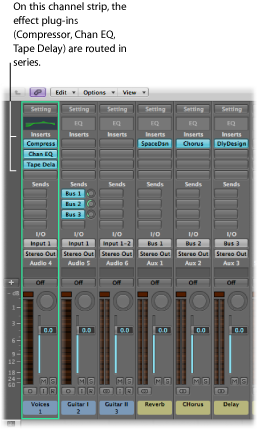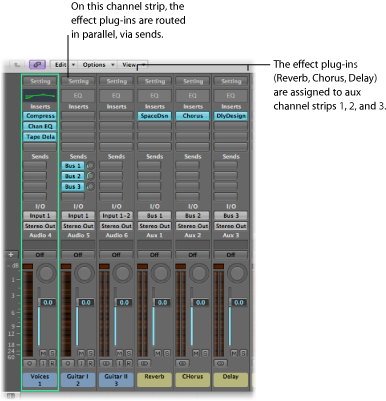Adding and Routing Effects in the Mixer
You add effects to channel strips in the Mixer in the same way as in the Arrange window—using a channel strip’s Insert slot.
There are two different ways to use effects:
- As (insert) effect processors: To add effects directly to a channel strip’s main signal.
- As send effects: To isolate effects from a channel strip’s main signal or to send several signals to the same effect.
The following sections explain how you can route effects in many different ways, enabling you to create complex mixing scenarios.
Sonically, the result of using effects as effect processors sounds nothing like the result of using send effects. Take the example of using a common effects combo, such as Reverb-Chorus-Delay. Inserting the effects directly into the channel strip signal results in a very different sound when compared to adding an effect send/return loop to the channel strip signal.
Routing Audio in the Mixer via Insert Effects
You use insert effects when you want to add effects directly into the channel strip’s signal flow. In this way, the channel strip’s entire signal is processed by the effect plug-in.
When multiple effect plug-ins are routed into a channel strip via inserts, they are said to be routed in series. In this type of configuration, the output of one effect is added to the incoming signal and becomes the input of the next effect in the chain.
The figure below illustrates this process:

Routing Audio in the Mixer via Send Effects
You use send effects when you want to isolate effect plug-ins from a channel strip’s signal flow, or when you want to use the same effect on more than one channel strip.
By creating a send, you split the channel strip’s signal in two. The channel strip’s main signal continues its route to the chosen output. The other part of the signal is routed down a parallel path, via a bus to an aux channel strip. You use the Send level knob to control the amount of the signal sent via the bus. This is known as parallel routing.
You can choose to route the signal back into the main signal flow at a later point, or you can choose to output the signal from the aux channel strip.
The following example shows a channel strip routed to multiple aux channel strips via sends—with reverb, chorus, and delay effects assigned to aux channel strips 1, 2, and 3, respectively.

The channel strip’s signal is split and routed to three separate effects, one on each aux channel strip. These three independent signals are then sent back from the respective aux channel strips and combined into an output stream from the original channel strip.
You can create up to eight sends on each audio, instrument, or aux channel strip. The behavior of sends is the same across Mixer and Arrange channel strips. For details about working with send effects, see Using Send Effects.